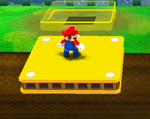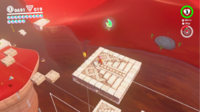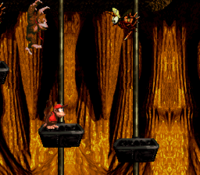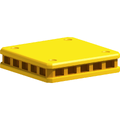Lift: Difference between revisions
LinkTheLefty (talk | contribs) No edit summary |
|||
| (5 intermediate revisions by 3 users not shown) | |||
| Line 7: | Line 7: | ||
|variants=[[#List of lifts|See below]] | |variants=[[#List of lifts|See below]] | ||
}} | }} | ||
'''Lifts'''<ref>{{cite|author=Pelland, Scott, and Dan Owsen|title=''Super Mario 64 Player's Guide''|location=Redmond|publisher=[[Nintendo|Nintendo of America]]| | '''Lifts'''<ref>{{cite|author=Pelland, Scott, and Dan Owsen|date=1996|title=''Super Mario 64 Player's Guide''|location=Redmond|publisher=[[Nintendo|Nintendo of America]]|language=en-us|page=58}}</ref><ref>''Super Mario Maker'' in-game name</ref> (also known as '''elevators''')<ref>{{cite|author=Musa, Alexander, and Geson Hatchett|date=November 22, 2013|title=''Super Mario 3D World'' PRIMA Official Game Guide|publisher=Prima Games|language=en-us|isbn=978-0804162494|page=167}}</ref><ref>''Mario vs. Donkey Kong 2: March of the Minis'' in-game help (no. 08)</ref> are thin platforms that appear throughout the [[Super Mario (franchise)|''Super Mario'' franchise]]. They typically are suspended in the air and move, enabling the player character to reach different heights and cross gaps. Some move by themselves, while others are controlled by the player. They debuted in ''[[Donkey Kong (game)|Donkey Kong]]''. | ||
Lifts that move along wire-like [[track]]s in the ''[[Super Mario (series)|Super Mario]]'' and ''[[Yoshi's Island (series)|Yoshi's Island]]'' series are sometimes referred to as '''Flatbed Ferries'''.<ref>{{cite|quote=Stand on the Flatbed Ferry platform above this first Star Coin, and wait for the Flatbed Ferry to slide to the right.|author=Stratton, Steve|date=2012|title=''New Super Mario Bros. U: PRIMA Official Game Guide''|location=Roseville|publisher=[[Prima Games]]|language=en-us|isbn=978-0-307-89690-2|page=68}}</ref> | |||
==History== | ==History== | ||
===''Donkey Kong''=== | ===''Donkey Kong''=== | ||
''[[Donkey Kong (game)|Donkey Kong]]'' features a lift that travels upward and another going downward in [[75m|75 m]], traveling along what appears to be a track. Both lifts spawn another elevator when one reaches the end of the path. [[Switch (Donkey Kong)|Switch]]es that reverse their direction appear in some levels of the [[Donkey Kong (Game Boy)|Game Boy game]]. | |||
===''Mario Bros. Special''=== | ===''Mario Bros. Special''=== | ||
A lift that takes [[Mario]] or [[Luigi]] to the upper [[conveyor belt]]s appears in ''[[Mario Bros. Special]]''. | |||
===''Super Mario'' series=== | ===''Super Mario'' series=== | ||
====''Super Mario Bros.'' / ''Super Mario Bros.: The Lost Levels''==== | ====''Super Mario Bros.'' / ''Super Mario Bros.: The Lost Levels''==== | ||
[[File:SMB NES World 6-3 Screenshot.png| | [[File:SMB NES World 6-3 Screenshot.png|thumb|Screenshot from ''[[Super Mario Bros.]]'' of a lift being used in World 6-3]] | ||
[[File:SMBPlatform.png|frame|left]] | [[File:SMBPlatform.png|frame|left]] | ||
'''Vertical Lifts'''<ref name=Win>{{cite|author=Tochikubo, Hiroo|date=1987|title=''[[How to win at Super Mario Bros.]]''|publisher=Tokuma Shoten|language=en-us|isbn=4-19-720003-XC|page=47}}.</ref> are first found in [[World 1-2 (Super Mario Bros.)|World 1-2]] of ''[[Super Mario Bros.]]'', functioning like in ''Donkey Kong''. However, [[World 1-3 (Super Mario Bros.)|World 1-3]] adds a variation that moves up and down. The game adds several varieties in general. [[World 3-3 (Super Mario Bros.)|World 3-3]] adds [[Flimsy Lift]]s, which move down when stood on. There are [[Scale Lift|Balance Lift]]s, which push down from the weight of [[Mario]] or [[Luigi]], putting them at risk of falling into a [[pit]] if they stand on for too long. The lifts are solid, meaning Mario and Luigi cannot land on top by jumping through them. Lifts look like the platforms that make up [[100m]] in ''Donkey Kong'', though the original [[Family Computer Disk System]] of ''[[Super Mario Bros.: The Lost Levels]]'' composes them of mushrooms. There are also '''Horizontal Lifts''',<ref name=Win/> which move back and forth. | |||
====''Super Mario Bros. 3'' / ''Super Mario Advance 4: Super Mario Bros. 3''==== | ====''Super Mario Bros. 3'' / ''Super Mario Advance 4: Super Mario Bros. 3''==== | ||
Lifts, like [[Hard Block]]s in ''[[Super Mario Bros. 3]]''. The game adds '''Rail Lifts''',<ref>{{cite|date=1990|title=''Super Mario Bros. 3'' English instruction booklet|publisher=Nintendo of America|language=en-us|page=19}}</ref> debuting in [[World 1-6 (Super Mario Bros. 3)|World 1-6]] and traveling along a track, and moving Flimsy Lifts, debuting in [[World 1-4 (Super Mario Bros. 3)|World 1-4]], that collapse to the bottom when stood on. | |||
Certain [[World-e]] levels of ''[[Super Mario Advance 4: Super Mario Bros. 3]]'' include two more varieties based on their appearance in ''Super Mario Bros.'' and ''Super Mario World''. [[Wild Ride in the Sky]], [[Caped Escape]], [[Koopaling Confusion]], [[Classic World 1-2]], [[Classic World 1-3]] and [[Classic World 1-4]] includes those based on ''Super Mario Bros.'', while [[Rich with Ropes]] include several stationary lifts based on their design in ''Super Mario World''. [[A Towering Tour]] has fast-moving gray lifts that work like the ''Super Mario Bros.''-based lifts but are shaped like the lifts from ''Super Mario Bros. 3'', and they follow a shorter path compared to normal lifts; they move faster on [[track]]s. | |||
====''Super Mario World'' / ''Super Mario World: Super Mario Advance 2''==== | ====''Super Mario World'' / ''Super Mario World: Super Mario Advance 2''==== | ||
Lifts | Lifts return in ''[[Super Mario World]]'' and [[Super Mario World: Super Mario Advance 2|its reissue]], this time with a gray or cream color. The Rail Lift returns with the title '''Pulley Lift'''<ref>{{cite|date=August 1991|title=Nintendo ''[[Mario Mania]]'' Player's Guide|publisher=[[Nintendo Power]]|language=en-us|page=70 and 71}}</ref> (or '''Pully Lift''').<ref>{{cite|date=2002|title=''Nintendo Power Advance'' Volume 4|publisher=Nintendo of America|language=en-us|page=29}}</ref> There are [[Single Swing Lift]]s, consisting of a platform on a swing, with a brown version that rotates around a central pivot point when stepped on and a gray version that swings perpetually. There is also the [[Triple Swing Lift]], consisting of three swinging gray platforms; a [[Flying Platform]], a set of gray [[Rotating Block]]s that cannot spin with wings; [[Lava Lift|Skull Raft]], a raft of skulls on [[lava]]; a [[diagonal platform]], an orange lift with a grassy top; the [[Count-Lift]], an upright grassy platform with a countdown timer; and the [[Piston Lift]], a mushroom variant of the Balance Lift. | ||
====''Super Mario Land 2: 6 Golden Coins''==== | ====''Super Mario Land 2: 6 Golden Coins''==== | ||
''[[Super Mario Land 2: 6 Golden Coins]]'' introduces a [[Bone Lift (Super Mario Land 2: 6 Golden Coins)|Bone Lift]] | ''[[Super Mario Land 2: 6 Golden Coins]]'' introduces a [[Bone Lift (Super Mario Land 2: 6 Golden Coins)|Bone Lift]], which rises when stood on, working the opposite of a Flimsy Lift, but freezes in place if not stood on. | ||
====''Super Mario 64'' / ''Super Mario 64 DS''==== | ====''Super Mario 64'' / ''Super Mario 64 DS''==== | ||
[[File:Elevatortour.png|thumb| | [[File:Elevatortour.png|thumb|Screenshot of a lift being used in ''[[Super Mario 64]]'']] | ||
Most lifts in ''[[Super Mario 64]]'' and ''[[Super Mario 64 DS]]'' are textured with a checkerboard pattern of tan and green. Some pairs of lifts move and rotate around both sides of a vertical beam, flipping upon reaching the top, like in [[Whomp's Fortress]] and [[The Secret Under the Moat|Vanish Cap Under the Moat]]. The lifts of [[Hazy Maze Cave]] move along black spheres, and there are large orange lifts with yellow and black details that move between floors as well as the controllable [[Work Elevator]] at one point. [[Lethal Lava Land]] similarly has lifts that travel along black spheres. [[Wet-Dry World]] has [[Arrow Lift (Super Mario 64)|Arrow Lift]]s, which move back and forth when stepped upon. The course also has the '''Express Elevator''', which can be stepped on from outside so then the player can ride the part inside of the mesh and get the [[Power Star]] of "[[Express Elevator--Hurry Up!]]." [[Tick Tock Clock]] has vertically moving yellow rectangular lifts, though their speed and direction vary depending on when the course is entered, and a "[[The Pit and the Pendulums]]" has a brown cube, an obstacle that moves up and down. | |||
Most lifts in ''[[Super Mario 64]]'' and ''[[Super Mario 64 DS]]'' | |||
{{br|left}} | {{br|left}} | ||
====''Super Mario Galaxy 2''==== | ====''Super Mario Galaxy 2''==== | ||
[[File:SMG2 Lift Platform.png|thumb|150px|Mario on a lift in ''Super Mario Galaxy 2'']] | [[File:SMG2 Lift Platform.png|thumb|150px|Mario on a lift in ''Super Mario Galaxy 2'']] | ||
The Lifts of ''[[Super Mario Galaxy 2]]'' appear in [[Sky Station Galaxy]], are yellow and rise before flashing blue and disappearing. They have a giant counterpart in [[Supermassive Galaxy]]. | |||
====''Super Mario 3D Land'' / ''Super Mario 3D World'' / ''Super Mario 3D World + Bowser's Fury''==== | ====''Super Mario 3D Land'' / ''Super Mario 3D World'' / ''Super Mario 3D World + Bowser's Fury''==== | ||
Lifts in ''[[Super Mario 3D Land]]'', ''[[Super Mario 3D World]]'', and | Lifts in ''[[Super Mario 3D Land]]'', ''[[Super Mario 3D World]]'', and Super Mario 3D World + Bowser's Fury|the latter's port]] have the same design and function as in ''Super Mario Galaxy 2'' but do not vanish. | ||
====''Super Mario Maker'' / ''Super Mario Maker for Nintendo 3DS''==== | ====''Super Mario Maker'' / ''Super Mario Maker for Nintendo 3DS''==== | ||
[[File:SMM-SMB-MovingPlatform.png|frame|left]] | [[File:SMM-SMB-MovingPlatform.png|frame|left]] | ||
Lifts in ''[[Super Mario Maker]]'' | Lifts in ''[[Super Mario Maker]]'', [[Super Mario Maker for Nintendo 3DS|its port]], and ''[[Super Mario Maker 2]]'' can travel in a preset direction and be placed on a [[track]]. Lifts can be shaken to become the blue Flimsy Lifts, which travel along a track when stepped on. A lift on a track in the ''Super Mario World'' style has a tile largely similar to the [[Chainsaw]]. The ''Super Mario 3D World'' style of ''Super Mario Maker 2'' turns lifts into the form of [[Cloud Lift]]s. | ||
====''Super Mario Run''==== | ====''Super Mario Run''==== | ||
| Line 61: | Line 56: | ||
[[File:SMO Sand Moon 73.png|thumb|A lift leading to Moe-Eye Habitat]] | [[File:SMO Sand Moon 73.png|thumb|A lift leading to Moe-Eye Habitat]] | ||
[[File:Moving platform Super Mario Odyssey.png|thumb|left|A lift in the Ice Cave]] | [[File:Moving platform Super Mario Odyssey.png|thumb|left|A lift in the Ice Cave]] | ||
Lifts (referred to as '''moving platforms''' in the [[Prima Games|Prima]] guide)<ref>{{cite|author=Walsh, Doug; Epstein, Joe|title=''Super Mario Odyssey'' Prima Official Guide | Lifts (referred to as '''moving platforms''' in the [[Prima Games|Prima]] guide)<ref>{{cite|author=Walsh, Doug; Epstein, Joe|date=October 27, 2017|title=''Super Mario Odyssey'' Prima Official Guide|publisher=Prima Games|language=en-us|isbn=978-0744018882|page=54, 59, 68, 71, 73}}</ref> appear in varying designs and sizes in ''[[Super Mario Odyssey]]''. The [[Tostarena Ruins]] of the [[Sand Kingdom]] has large stone lifts depicting the [[Inverted Pyramid]] after completing "[[Atop the Highest Tower]]" as well as in the Ice Cave, albeit darker, covered with ice. The stone lifts move along a [[track]] when stepped on, and those of Tostarena Ruins take Mario to [[Moe-Eye Habitat]], where smaller variations are used to collect [[Moon Shard]]s. Larger versions of the stone lifts from Moe-Eye Habitat are in the sub-area with the Power Moon for the sidequest [[List of Power Moons in the Sand Kingdom#Jaxi Driver|Jaxi Driver]]. | ||
The 2D segments have lifts reusing their graphics from ''[[Super Mario Bros.]]'' The sidequest [[List of Power Moons in the Cascade Kingdom#Past the Chasm Lifts|Past the Chasm Lifts]] of [[Cascade Kingdom]] has lifts that work like those in [[World 1-2 (Super Mario Bros.)|World 1-2]] of ''Super Mario Bros.'' | |||
{{br}} | {{br}} | ||
===''Donkey Kong Country'' series=== | ===''Donkey Kong Country'' series=== | ||
====''Donkey Kong Country''==== | ====''Donkey Kong Country''==== | ||
[[File:Elevator Antics SNES.png|thumb|[[Donkey Kong]] and [[Diddy Kong]] in the [[Elevator Antics]] level of ''[[Donkey Kong Country]]'']] | [[File:Elevator Antics SNES.png|thumb|[[Donkey Kong]] and [[Diddy Kong]] in the [[Elevator Antics]] level of ''[[Donkey Kong Country]]'']] | ||
Elevators in ''[[Donkey Kong Country]]'' | Elevators in ''[[Donkey Kong Country]]'' travel up or down from a steel pole in [[Elevator Antics]]. | ||
====''Donkey Kong Country 3: Dixie Kong's Double Trouble!''==== | ====''Donkey Kong Country 3: Dixie Kong's Double Trouble!''==== | ||
Wooden lifts that move up and down are in the mill stages, [[Fire-Ball Frenzy]], and [[Rocket Rush (level)|Rocket Rush]] of ''[[Donkey Kong Country 3: Dixie Kong's Double Trouble!]]'', as well as [[Dingy Drain-Pipe]] in [[Donkey Kong Country 3 (Game Boy Advance)|the remake]]. A lift that moves horizontally is in the first boss fight with [[King K. Rool#Donkey Kong Country 3: Dixie Kong's Double Trouble!|Baron K. Roolenstein]]. Certain lifts only move when stepped on by the player characters. | |||
===''Yoshi'' | ===''Yoshi'' series=== | ||
====''Yoshi's Island'' series==== | ====''Yoshi's Island'' series==== | ||
Every game of the ''[[Yoshi's Island (series)|Yoshi's Island]]'' series has Flatbed Ferries, which typically follow a preset path marked by a [[track]] when [[jump]]ed upon until reaching a little red sphere at the end. Upon reaching the end, a Flatbed Ferry switches its direction of movement; if the line ends without a sphere, the Flatbed Ferry falls down, but it may be "caught" by another track if it falls on one, and it starts following it. | |||
Flatbed Ferries appear in a variety of colors, such as green, yellow, and red, with each getting progressively faster; in the isometric sections found in certain [[fortress]]es, the colors are a pale pink, periwinkle, and cyan. Magenta ones appear as part of [[Paddle Platform|paddle wheel]]s. The [[liquid lift]] and [[Blarggwich]] carry green Flatbed Ferries. | Flatbed Ferries appear in a variety of colors, such as green, yellow, and red, with each getting progressively faster; in the isometric sections found in certain [[fortress]]es, the colors are a pale pink, periwinkle, and cyan. Magenta ones appear as part of [[Paddle Platform|paddle wheel]]s. The [[liquid lift]] and [[Blarggwich]] carry green Flatbed Ferries. | ||
| Line 90: | Line 79: | ||
====''Yoshi Topsy-Turvy''==== | ====''Yoshi Topsy-Turvy''==== | ||
Lifts | Lifts are the smaller '''Half Lifts''' (ハーフリフト).<ref>{{cite|date=March 1, 2005|isbn=4-09-106215-6|title=「ヨッシーの万有引力任天堂公式ガイドブック」 (''Yoshi Banyū Inryoku Nintendo Kōshiki Guidebook''|publisher=Shogakukan|language=ja|page={{file link|YUG Shogakukan P20.jpg|20}}}}</ref> are usable in ''[[Yoshi Topsy-Turvy]]''. Lifts bear a green zig-zag pattern and a brown rocky pattern. They are attached either to chains or rails. The player can tilt their system to have the lifts move. There are worn-out brown lifts, which fall at the end of a rail. | ||
===''Game & Watch Gallery 2''=== | ===''Game & Watch Gallery 2''=== | ||
Flatbed Ferries are activated temporarily from a lever in the Modern ''[[Donkey Kong (Game & Watch)|Donkey Kong]]'' in ''[[Game & Watch Gallery 2]]'' They are the last platforms used in the first stage, where it moves like a paddle wheel, doing four turns within a full rotation, and the second stage, where they swing from side to side on a chain. | |||
===''Super Smash Bros.'' series=== | ===''Super Smash Bros.'' series=== | ||
{{main-wiki|SmashWiki|Platform}} | |||
[[File:SSBM Yoshi's Story Cloud.png|frame|left]] | [[File:SSBM Yoshi's Story Cloud.png|frame|left]] | ||
A smiling cloud | Lifts appear in the [[Super Smash Bros. (series)|''Super Smash Bros.'' series]] as platforms in various stages themed after the [[Super Mario (franchise)|''Super Mario'' franchise]]. A {{iw|smashwiki|Yoshi's Story#Randall the Cloud|smiling cloud lift}} appears in the [[Yoshi's Story (stage)|Yoshi's Story]] stage of ''[[Super Smash Bros. Melee]]'', also returning in ''[[Super Smash Bros. Ultimate]]''; it moves along a dotted line and utilizes its design from ''Yoshi's Story''. The lifts of [[75 m (stage)|75 m]] in ''[[Super Smash Bros. Brawl]]'' and its reappearances in ''[[Super Smash Bros. for Wii U]]'' and ''[[Super Smash Bros. Ultimate]]'' work exactly like in the original 75m. ''Super Smash Bros. Brawl'' also includes rusted lifts in the [[World 1-2 (Super Mario Bros.)|World 1-2]] version of [[Mushroomy Kingdom]], except they are [[Semisolid Platform|pass-through platforms]], unlike the original ''[[Super Mario Bros.]]'' iteration. ''[[Super Smash Bros. for Nintendo 3DS]]'' includes the lifts of ''[[Super Mario 3D Land]]'' as platforms. 3D Land starts on three motionless lifts, and players battle on four multi-colored lifts while being transitioned from the second to third portion, with rocks possibly altering their angle. | ||
[[ | |||
{{iw|smashwiki|PictoChat 2}} of ''[[Super Smash Bros. for Nintendo 3DS]]'' may feature segment from World 1-2 of ''Super Mario Bros.'' showing a row of blocks between a pair of continuously moving lifts. | |||
===''Mario & Luigi: Superstar Saga'' / ''Mario & Luigi: Superstar Saga + Bowser's Minions''=== | ===''Mario & Luigi: Superstar Saga'' / ''Mario & Luigi: Superstar Saga + Bowser's Minions''=== | ||
''[[Mario & Luigi: Superstar Saga]]'' and [[Mario & Luigi: Superstar Saga + Bowser's Minions|its port]], has some lifts in [[Guffawha Ruins]] and the caves of [[Beanbean Fields]]. One lift to [[Little Fungitown]] is at the end of [[Teehee Valley]]. The game also adds the [[Spin Block (Mario & Luigi: Superstar Saga)|Spin Block]] variety. | |||
===''Mario vs. Donkey Kong'' series=== | ===''Mario vs. Donkey Kong'' series=== | ||
====''Mario vs. Donkey Kong''==== | ====''Mario vs. Donkey Kong''==== | ||
The lifts of ''[[Mario vs. Donkey Kong]]'' and [[Mario vs. Donkey Kong (Nintendo Switch)|its remake]] are similar to those from ''Donkey Kong''. They appear at one end of a track repeatedly before traveling in another direction and disappearing at the other end, and a [[Direction Switch]] can sometimes change the direction of every lift in a level. | |||
====''Mario vs. Donkey Kong 2: March of the Minis''==== | ====''Mario vs. Donkey Kong 2: March of the Minis''==== | ||
[[File:Elevator.png|frame|[[Mini Mario (toy)|Mini Mario]]s riding an elevator in ''[[Mario vs. Donkey Kong 2: March of the Minis]]'']] | [[File:Elevator.png|frame|[[Mini Mario (toy)|Mini Mario]]s riding an elevator in ''[[Mario vs. Donkey Kong 2: March of the Minis]]'']] | ||
Elevators and '''Moving Platforms'''<ref>''Mario vs. Donkey Kong 2: March of the Minis'' in-game help (no. 20)</ref> (also known as '''Path Platforms'''),<ref>''Mario vs. Donkey Kong 2: March of the Minis'' object graphics filename (<tt>data/anims/path_platform_anim.bin</tt>)</ref> are the two types of lifts in ''[[Mario vs. Donkey Kong 2: March of the Minis]]''. | |||
Elevators are | Elevators are platforms attached to a pole, like before, and are first found in [[Room 1-5 (Mario vs. Donkey Kong 2: March of the Minis)|Room 1-5]] of [[Mushroom Mayhem]]. At a wall next to an elevator is a '''control panel''',<ref>{{cite|url=www.nintendo.com/consumer/gameslist/manuals/DS_Mario_vs_Donkey_Kong_March_of_the_Minis.pdf|title=''Mario vs. Donkey Kong 2: March of the Minis'' instruction booklet|publisher=Nintendo of America|language=en-us|page=21|accessdate=July 31, 2022}}</ref> depicted with buttons looking like up and down arrows that turn green when activated. An elevator can have up to two [[Mini]]s, and the {{button|ds|Stylus}} either raises or lowers the platform from the control panel accordingly. The direction of an elevator can be altered once it reaches a ground or the top of the pole. | ||
[[File:MvDK2 Moving Platform.png|frame|left]] | [[File:MvDK2 Moving Platform.png|frame|left]] | ||
Moving Platforms are | Moving Platforms are first found in [[Room 6-3]] of [[Toadstool Castle]] and move along a path automatically, stopping whenever at any ledge and extending their platform slightly, allowing only one Mini to go on board. | ||
===''WarioWare'' series=== | ===''WarioWare'' series=== | ||
Lifts on [[track]]s from ''Super Mario Bros. 3'' appear in the microgame [[Super Mario Bros. 3 (lift microgame)|Super Mario Bros. 3-Lift]] in ''[[WarioWare: Twisted!]]'' and ''[[WarioWare Gold]]'' (renamed to simply "Super Mario Bros. 3" in the latter). The player has to rotate the system to move the platforms and make Mario avoid the multiple enemies coming for him. In the third level, another lift appears along with Luigi on it, who also needs to be protected. | Lifts on [[track]]s from ''Super Mario Bros. 3'' appear in the microgame [[Super Mario Bros. 3 (lift microgame)|Super Mario Bros. 3-Lift]] in ''[[WarioWare: Twisted!]]'' and ''[[WarioWare Gold]]'' (renamed to simply "Super Mario Bros. 3" in the latter). The player has to rotate the system to move the platforms and make Mario avoid the multiple enemies coming for him. In the third level, another lift appears along with Luigi on it, who also needs to be protected. | ||
===''Super Princess Peach''=== | |||
Flatbed Ferries appear in ''[[Super Princess Peach]]'' with a similar role as in ''[[Super Mario World 2: Yoshi's Island]]''. | |||
===''Super Paper Mario''=== | ===''Super Paper Mario''=== | ||
Lifts are depicted with a yellow and orange zigzag pattern in ''[[Super Paper Mario]]''. The player uses horizontal and vertical lifts in places such as [[Yold Desert]], the [[Floro Caverns]], and [[The Overthere]] to reach certain areas. [[The Bitlands]] has a pixelated variation resembling its design from ''Super Mario Bros.'', and there are vertically traveling lifts underground. The [[Castle Bleck Inner Sanctum]] has black lifts with white outlines. | |||
===''Mario Party: Island Tour''=== | ===''Mario Party: Island Tour''=== | ||
Lifts are featured in the minigame [[Gyro for the Gold]] in ''[[Mario Party: Island Tour]]'', where players try to cross two of them to complete the obstacle course. | |||
===''Captain Toad: Treasure Tracker'' (Nintendo Switch)=== | ===''Captain Toad: Treasure Tracker'' (Nintendo Switch)=== | ||
Lifts reappear in the [[Nintendo Switch]] version of ''[[Captain Toad: Treasure Tracker]]'' | Lifts reappear in the [[Nintendo Switch]] version of ''[[Captain Toad: Treasure Tracker]]''. They replace the [[Propeller Platform]]s because the [[Nintendo Switch]] has no usable microphone. | ||
===''Mario Kart'' series=== | ===''Mario Kart'' series=== | ||
| Line 151: | Line 133: | ||
==List of lifts== | ==List of lifts== | ||
Lifts are the basis for many other platforms. For many of them, this is apparent with the inclusion of {{ | Lifts are the basis for many other platforms. For many of them, this is apparent with the inclusion of {{ruby|リフト|Rifuto}} ("Lift") in their Japanese name, which is not always carried over during localization. Most derived lifts are suspended in the air and move, either on their own or when a player character steps on them. | ||
{{columns| | {{columns| | ||
*[[Arrow lift (New Super Mario Bros. series)|Arrow lift (''New Super Mario Bros.'' series)]] | *[[Arrow lift (New Super Mario Bros. series)|Arrow lift (''New Super Mario Bros.'' series)]] | ||
| Line 251: | Line 232: | ||
{{foreign names | {{foreign names | ||
|Jpn=リフト | |Jpn=リフト | ||
|JpnC=<ref>{{cite|author=Sakai, Kazuya (Ambit), kikai, Akinori Sao, Junko Fukuda, Kunio Takayama, and Ko Nakahara (Shogakukan), editors|title=『[[Super Mario Bros. Encyclopedia|スーパーマリオブラザーズ百科: 任天堂公式ガイドブック]]』 | |JpnC=<ref>{{cite|author=Sakai, Kazuya (Ambit), kikai, Akinori Sao, Junko Fukuda, Kunio Takayama, and Ko Nakahara (Shogakukan), editors|date=2015|title=『[[Super Mario Bros. Encyclopedia|スーパーマリオブラザーズ百科: 任天堂公式ガイドブック]]』|location=Tokyo|publisher=[[Shogakukan]]|language=ja|page=21, 29, 41, 48, 61, 78, 92, 119, 137, 151, 171, 186, 201, 217, 234}}</ref><ref>{{cite|author=KADOKAWA Game Linkage, editors|date=2023|title=『スーパーマリオブラザーズ ワンダー かんぺき攻略本』|location=Tokyo|publisher=Kadokawa|language=ja|isbn=4-047337-02-1|page=62}}</ref> | ||
|JpnR=Rifuto | |JpnR=Rifuto | ||
|JpnM=Lift | |JpnM=Lift | ||
|Jpn2=エレベーター | |Jpn2=エレベーター | ||
|Jpn2C=<ref>{{cite|title=''Mario & Wario'' instruction booklet| | |Jpn2C=<ref>{{cite|date=1993|title=''Mario & Wario'' instruction booklet|publisher=Nintendo|language=ja|page=9}}</ref> | ||
|Jpn2R=Erebētā | |Jpn2R=Erebētā | ||
|Jpn2M=Elevator | |Jpn2M=Elevator | ||
| Line 283: | Line 264: | ||
|ItaM=Elevator | |ItaM=Elevator | ||
|Ita2M=Platform | |Ita2M=Platform | ||
|Ita3=Piattaforma mobile | |||
|Ita3M=Mobile platform | |||
|Ita3C=<ref>{{cite|quote=TIP — Sali sopra all'ultimo soffitto usando la piattaforma mobile nel MONDO 1-2 per trovare tubi capaci di portarti nel MONDO 2, 3 e 4.|date=March 26, 2025|title=Una guida al mondo di Super Mario — MONDO 1 — Super Mario Bros|publisher=[[Nintendo Today!]]|language=it|accessdate=March 27, 2025}}</ref> | |||
|Fre=Plateforme | |Fre=Plateforme | ||
|Fre2=Ascenseur | |Fre2=Ascenseur | ||
| Line 295: | Line 279: | ||
|JpnR=Sen Rifuto | |JpnR=Sen Rifuto | ||
|JpnM=Track Lift | |JpnM=Track Lift | ||
|Jpn2= | |Jpn2=センリフト | ||
|Jpn2C=<ref>{{cite| | |Jpn2C=<ref>{{cite|date=November 20, 1995|title=「オールカラー版 スーパーマリオヨッシーアイランド全百科」 (''All-Color Ban - Super Mario: Yossy Island All Hyakka'')|publisher=Shogakukan|language=ja|page=92}}</ref> | ||
|Jpn2R=Sen Rifuto | |Jpn2R=Sen Rifuto | ||
|Jpn2M=Track Lift | |Jpn2M=Track Lift | ||
|Jpn3=レールリフト | |Jpn3=線リフト | ||
| | |Jpn3C=<ref>{{cite|author=----|date=2015|title=『[[Super Mario Bros. Encyclopedia|スーパーマリオブラザーズ百科: 任天堂公式ガイドブック]]』|location=Tokyo|publisher=[[Shogakukan]]|language=ja|page=60, 118, 150, 200, 216}}</ref> | ||
| | |Jpn3R=Sen Rifuto | ||
| | |Jpn3M=Track Lift | ||
| | |Jpn4=レールリフト | ||
|Jpn4C=<ref>{{cite|date=1988|title=''Super Mario Bros. 3'' Japanese instruction booklet|publisher=Nintendo|language=ja|page=17}}</ref> | |||
|Jpn4R=Rēru Rifuto | |||
|Jpn4M=Rail Lift | |||
|Jpn4N=''Super Mario Bros. 3'' | |||
|SpaE=Transbordador | |SpaE=Transbordador | ||
|SpaEM=Ferry | |SpaEM=Ferry | ||
Latest revision as of 09:09, March 30, 2025
- "Elevator" redirects here. For the object in Donkey Kong's Crash Course in Nintendo Land, see Automated elevator. For the object in Super Mario Land also referred to as an Elevator, see Lift Block.
| Lift | |||
|---|---|---|---|
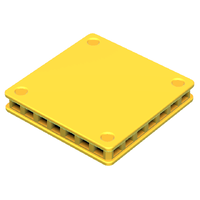 Artwork from Captain Toad: Treasure Tracker | |||
| First appearance | Donkey Kong (1981) | ||
| Latest appearance | Mario & Luigi: Brothership (2024) | ||
| Effect | Platforms that are either suspended in the air or move in set patterns | ||
| |||
Lifts[1][2] (also known as elevators)[3][4] are thin platforms that appear throughout the Super Mario franchise. They typically are suspended in the air and move, enabling the player character to reach different heights and cross gaps. Some move by themselves, while others are controlled by the player. They debuted in Donkey Kong.
Lifts that move along wire-like tracks in the Super Mario and Yoshi's Island series are sometimes referred to as Flatbed Ferries.[5]
History[edit]
Donkey Kong[edit]
Donkey Kong features a lift that travels upward and another going downward in 75 m, traveling along what appears to be a track. Both lifts spawn another elevator when one reaches the end of the path. Switches that reverse their direction appear in some levels of the Game Boy game.
Mario Bros. Special[edit]
A lift that takes Mario or Luigi to the upper conveyor belts appears in Mario Bros. Special.
Super Mario series[edit]
Super Mario Bros. / Super Mario Bros.: The Lost Levels[edit]
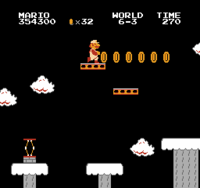
Vertical Lifts[6] are first found in World 1-2 of Super Mario Bros., functioning like in Donkey Kong. However, World 1-3 adds a variation that moves up and down. The game adds several varieties in general. World 3-3 adds Flimsy Lifts, which move down when stood on. There are Balance Lifts, which push down from the weight of Mario or Luigi, putting them at risk of falling into a pit if they stand on for too long. The lifts are solid, meaning Mario and Luigi cannot land on top by jumping through them. Lifts look like the platforms that make up 100m in Donkey Kong, though the original Family Computer Disk System of Super Mario Bros.: The Lost Levels composes them of mushrooms. There are also Horizontal Lifts,[6] which move back and forth.
Super Mario Bros. 3 / Super Mario Advance 4: Super Mario Bros. 3[edit]
Lifts, like Hard Blocks in Super Mario Bros. 3. The game adds Rail Lifts,[7] debuting in World 1-6 and traveling along a track, and moving Flimsy Lifts, debuting in World 1-4, that collapse to the bottom when stood on.
Certain World-e levels of Super Mario Advance 4: Super Mario Bros. 3 include two more varieties based on their appearance in Super Mario Bros. and Super Mario World. Wild Ride in the Sky, Caped Escape, Koopaling Confusion, Classic World 1-2, Classic World 1-3 and Classic World 1-4 includes those based on Super Mario Bros., while Rich with Ropes include several stationary lifts based on their design in Super Mario World. A Towering Tour has fast-moving gray lifts that work like the Super Mario Bros.-based lifts but are shaped like the lifts from Super Mario Bros. 3, and they follow a shorter path compared to normal lifts; they move faster on tracks.
Super Mario World / Super Mario World: Super Mario Advance 2[edit]
Lifts return in Super Mario World and its reissue, this time with a gray or cream color. The Rail Lift returns with the title Pulley Lift[8] (or Pully Lift).[9] There are Single Swing Lifts, consisting of a platform on a swing, with a brown version that rotates around a central pivot point when stepped on and a gray version that swings perpetually. There is also the Triple Swing Lift, consisting of three swinging gray platforms; a Flying Platform, a set of gray Rotating Blocks that cannot spin with wings; Skull Raft, a raft of skulls on lava; a diagonal platform, an orange lift with a grassy top; the Count-Lift, an upright grassy platform with a countdown timer; and the Piston Lift, a mushroom variant of the Balance Lift.
Super Mario Land 2: 6 Golden Coins[edit]
Super Mario Land 2: 6 Golden Coins introduces a Bone Lift, which rises when stood on, working the opposite of a Flimsy Lift, but freezes in place if not stood on.
Super Mario 64 / Super Mario 64 DS[edit]
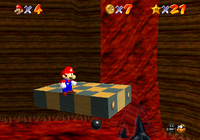
Most lifts in Super Mario 64 and Super Mario 64 DS are textured with a checkerboard pattern of tan and green. Some pairs of lifts move and rotate around both sides of a vertical beam, flipping upon reaching the top, like in Whomp's Fortress and Vanish Cap Under the Moat. The lifts of Hazy Maze Cave move along black spheres, and there are large orange lifts with yellow and black details that move between floors as well as the controllable Work Elevator at one point. Lethal Lava Land similarly has lifts that travel along black spheres. Wet-Dry World has Arrow Lifts, which move back and forth when stepped upon. The course also has the Express Elevator, which can be stepped on from outside so then the player can ride the part inside of the mesh and get the Power Star of "Express Elevator--Hurry Up!." Tick Tock Clock has vertically moving yellow rectangular lifts, though their speed and direction vary depending on when the course is entered, and a "The Pit and the Pendulums" has a brown cube, an obstacle that moves up and down.
Super Mario Galaxy 2[edit]
The Lifts of Super Mario Galaxy 2 appear in Sky Station Galaxy, are yellow and rise before flashing blue and disappearing. They have a giant counterpart in Supermassive Galaxy.
Super Mario 3D Land / Super Mario 3D World / Super Mario 3D World + Bowser's Fury[edit]
Lifts in Super Mario 3D Land, Super Mario 3D World, and Super Mario 3D World + Bowser's Fury|the latter's port]] have the same design and function as in Super Mario Galaxy 2 but do not vanish.
Super Mario Maker / Super Mario Maker for Nintendo 3DS[edit]
Lifts in Super Mario Maker, its port, and Super Mario Maker 2 can travel in a preset direction and be placed on a track. Lifts can be shaken to become the blue Flimsy Lifts, which travel along a track when stepped on. A lift on a track in the Super Mario World style has a tile largely similar to the Chainsaw. The Super Mario 3D World style of Super Mario Maker 2 turns lifts into the form of Cloud Lifts.
Super Mario Run[edit]
Lifts in Super Mario Run move on tracks in several levels. When the player lands on a Lift, they slowly center themselves on the lift, then do not move again until they jump from it. Some lifts only start moving if the player is standing on them. If a lift leaves a track, it does not reattach itself to any track, even one it originates from. After the player leaves a Lift in any way, most commonly by jumping but also by other platforms or enemies coming between their feet and the Lift, the Lift disappears. After some time has passed, the Lift reappears back in its original location. The lifts' designs are similar to the falling platforms in the final Bowser battle in New Super Mario Bros. 2.
Super Mario Odyssey[edit]
Lifts (referred to as moving platforms in the Prima guide)[10] appear in varying designs and sizes in Super Mario Odyssey. The Tostarena Ruins of the Sand Kingdom has large stone lifts depicting the Inverted Pyramid after completing "Atop the Highest Tower" as well as in the Ice Cave, albeit darker, covered with ice. The stone lifts move along a track when stepped on, and those of Tostarena Ruins take Mario to Moe-Eye Habitat, where smaller variations are used to collect Moon Shards. Larger versions of the stone lifts from Moe-Eye Habitat are in the sub-area with the Power Moon for the sidequest Jaxi Driver.
The 2D segments have lifts reusing their graphics from Super Mario Bros. The sidequest Past the Chasm Lifts of Cascade Kingdom has lifts that work like those in World 1-2 of Super Mario Bros.
Donkey Kong Country series[edit]
Donkey Kong Country[edit]
Elevators in Donkey Kong Country travel up or down from a steel pole in Elevator Antics.
Donkey Kong Country 3: Dixie Kong's Double Trouble![edit]
Wooden lifts that move up and down are in the mill stages, Fire-Ball Frenzy, and Rocket Rush of Donkey Kong Country 3: Dixie Kong's Double Trouble!, as well as Dingy Drain-Pipe in the remake. A lift that moves horizontally is in the first boss fight with Baron K. Roolenstein. Certain lifts only move when stepped on by the player characters.
Yoshi series[edit]
Yoshi's Island series[edit]
Every game of the Yoshi's Island series has Flatbed Ferries, which typically follow a preset path marked by a track when jumped upon until reaching a little red sphere at the end. Upon reaching the end, a Flatbed Ferry switches its direction of movement; if the line ends without a sphere, the Flatbed Ferry falls down, but it may be "caught" by another track if it falls on one, and it starts following it.
Flatbed Ferries appear in a variety of colors, such as green, yellow, and red, with each getting progressively faster; in the isometric sections found in certain fortresses, the colors are a pale pink, periwinkle, and cyan. Magenta ones appear as part of paddle wheels. The liquid lift and Blarggwich carry green Flatbed Ferries.
Yoshi's Story[edit]
Lifts in Yoshi's Story are featured in the form of smiling cloud platforms that move along tracks in the level Rail Lift. If a Baby Yoshi hits a switch present along the tracks by throwing an egg, the cloud platform can move to different tracks. Flatbed Ferries also return in the game.
Yoshi Topsy-Turvy[edit]
Lifts are the smaller Half Lifts (ハーフリフト).[11] are usable in Yoshi Topsy-Turvy. Lifts bear a green zig-zag pattern and a brown rocky pattern. They are attached either to chains or rails. The player can tilt their system to have the lifts move. There are worn-out brown lifts, which fall at the end of a rail.
Game & Watch Gallery 2[edit]
Flatbed Ferries are activated temporarily from a lever in the Modern Donkey Kong in Game & Watch Gallery 2 They are the last platforms used in the first stage, where it moves like a paddle wheel, doing four turns within a full rotation, and the second stage, where they swing from side to side on a chain.
Super Smash Bros. series[edit]
- SmashWiki article: Platform
Lifts appear in the Super Smash Bros. series as platforms in various stages themed after the Super Mario franchise. A smiling cloud lift appears in the Yoshi's Story stage of Super Smash Bros. Melee, also returning in Super Smash Bros. Ultimate; it moves along a dotted line and utilizes its design from Yoshi's Story. The lifts of 75 m in Super Smash Bros. Brawl and its reappearances in Super Smash Bros. for Wii U and Super Smash Bros. Ultimate work exactly like in the original 75m. Super Smash Bros. Brawl also includes rusted lifts in the World 1-2 version of Mushroomy Kingdom, except they are pass-through platforms, unlike the original Super Mario Bros. iteration. Super Smash Bros. for Nintendo 3DS includes the lifts of Super Mario 3D Land as platforms. 3D Land starts on three motionless lifts, and players battle on four multi-colored lifts while being transitioned from the second to third portion, with rocks possibly altering their angle.
PictoChat 2 of Super Smash Bros. for Nintendo 3DS may feature segment from World 1-2 of Super Mario Bros. showing a row of blocks between a pair of continuously moving lifts.
Mario & Luigi: Superstar Saga / Mario & Luigi: Superstar Saga + Bowser's Minions[edit]
Mario & Luigi: Superstar Saga and its port, has some lifts in Guffawha Ruins and the caves of Beanbean Fields. One lift to Little Fungitown is at the end of Teehee Valley. The game also adds the Spin Block variety.
Mario vs. Donkey Kong series[edit]
Mario vs. Donkey Kong[edit]
The lifts of Mario vs. Donkey Kong and its remake are similar to those from Donkey Kong. They appear at one end of a track repeatedly before traveling in another direction and disappearing at the other end, and a Direction Switch can sometimes change the direction of every lift in a level.
Mario vs. Donkey Kong 2: March of the Minis[edit]
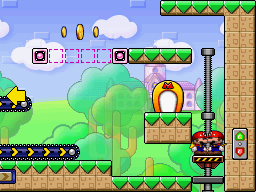
Elevators and Moving Platforms[12] (also known as Path Platforms),[13] are the two types of lifts in Mario vs. Donkey Kong 2: March of the Minis.
Elevators are platforms attached to a pole, like before, and are first found in Room 1-5 of Mushroom Mayhem. At a wall next to an elevator is a control panel,[14] depicted with buttons looking like up and down arrows that turn green when activated. An elevator can have up to two Minis, and the either raises or lowers the platform from the control panel accordingly. The direction of an elevator can be altered once it reaches a ground or the top of the pole.
Moving Platforms are first found in Room 6-3 of Toadstool Castle and move along a path automatically, stopping whenever at any ledge and extending their platform slightly, allowing only one Mini to go on board.
WarioWare series[edit]
Lifts on tracks from Super Mario Bros. 3 appear in the microgame Super Mario Bros. 3-Lift in WarioWare: Twisted! and WarioWare Gold (renamed to simply "Super Mario Bros. 3" in the latter). The player has to rotate the system to move the platforms and make Mario avoid the multiple enemies coming for him. In the third level, another lift appears along with Luigi on it, who also needs to be protected.
Super Princess Peach[edit]
Flatbed Ferries appear in Super Princess Peach with a similar role as in Super Mario World 2: Yoshi's Island.
Super Paper Mario[edit]
Lifts are depicted with a yellow and orange zigzag pattern in Super Paper Mario. The player uses horizontal and vertical lifts in places such as Yold Desert, the Floro Caverns, and The Overthere to reach certain areas. The Bitlands has a pixelated variation resembling its design from Super Mario Bros., and there are vertically traveling lifts underground. The Castle Bleck Inner Sanctum has black lifts with white outlines.
Mario Party: Island Tour[edit]
Lifts are featured in the minigame Gyro for the Gold in Mario Party: Island Tour, where players try to cross two of them to complete the obstacle course.
Captain Toad: Treasure Tracker (Nintendo Switch)[edit]
Lifts reappear in the Nintendo Switch version of Captain Toad: Treasure Tracker. They replace the Propeller Platforms because the Nintendo Switch has no usable microphone.
Mario Kart series[edit]
Mario Kart Tour[edit]
In Mario Kart Tour's Battle Mode, any opponents that are eliminated ride on lifts that move around the course and throw projectiles such as Green Shells, Bananas, and Bob-ombs onto the course.
Mario Kart 8 Deluxe[edit]
A pink Flatbed Ferry, with a Yoshi sitting on it, appears near the starting line of Yoshi's Island in the Booster Course Pass DLC pack for Mario Kart 8 Deluxe.
The Super Mario Bros. Movie[edit]
Lifts make an appearance in The Super Mario Bros. Movie, where they resemble and behave the same way they do in Super Mario 3D Land and Super Mario 3D World.
List of lifts[edit]
Lifts are the basis for many other platforms. For many of them, this is apparent with the inclusion of
- Arrow lift (New Super Mario Bros. series)
- Arrow Lift (Super Mario 64)
- Arrow wheel
- Balloon Bully
- Bell-shaped contraption
- Big Windmill
- Blarggwich
- Blarggwich (sandwich)
- Bolt Lift
- Bone lift
- Bone Lift (Super Mario Bros. Wonder)
- Bone Lift (Super Mario Land 2: 6 Golden Coins)
- Cloud Lift
- Count-Lift
- Cross Lift
- Diagonal platform
- Directional Lift
- Disappearing platform
- Donut Lift
- Dropdown Countdown Lift
- Elevator block
- Elevator lift
- Eye Beamer
- Flimsy Lift
- Floating barrel
- Floating couch
- Flying Platform
- Ghost-coaster
- Hinged device
- Hip Drop Move Lift
- Ice platform
- Lava Lift
- Liftoglobin
- Limited Lift
- Limited Lift (Remote-Control)
- Linking Lift
- Liquid lift
- Moving block
- Multi-Vator
- Paddle Platform
- Pendulum Platform
- Pinwheel
- Propeller Lift
- Propeller Lift (Super Mario Land 2: 6 Golden Coins)
- Propeller Platform
- Puffy Lift
- Pump Lift
- Raft
- Remote-Control Platform
- Remote-Controlled Lift
- Rocking Platform
- Rotary Lift
- Rotating Panel
- Scale Lift
- Screwtop Lift
- Screwtop Shroom
- Seesaw
- Segmented platform
- Single Swing Lift
- Ski Lift
- Sky Move Lift
- Slide Lift
- Spine Coaster (Super Mario 3D Land)
- Star Lift
- Stretch Shroom
- Swing
- Switch-Lift
- Tilt Lift
- Transparent Lift
- Triple Swing Lift
- White box
- Wire Net Platform
- Work Elevator
- Zipline lift
Profiles[edit]
Rail Lift[edit]
Super Mario Bros. 3[edit]
- Nintendo 3DS Virtual Console manual description:
- English:
Travel along rails.
- English:
Gallery[edit]
- For this subject's image gallery, see Gallery:Lift.
Names in other languages[edit]
Lift[edit]
| Language | Name | Meaning | Notes |
|---|---|---|---|
| Japanese | リフト[15][16] Rifuto |
Lift | |
| エレベーター[17] Erebētā |
Elevator | Mario & Wario | |
| Chinese | 升降梯[?] Shēngjiàngtī |
Lift | |
| 升降台[?] Shēngjiàng Tái |
Super Mario Maker 2 | ||
| Dutch | Platform[?] | Platform | |
| French | Plateforme[?] | Platform | |
| Ascenseur[21][22] | Elevator | ||
| German | Lift[19] | - | |
| Italian | Ascensore[?] | Elevator | |
| Piattaforma[?] | Platform | ||
| Piattaforma mobile[20] | Mobile platform | ||
| Russian | Платформа[?] Platforma |
Platform | |
| Spanish | Ascensor[?] | Elevator | |
| Elevador[18] |
Flatbed Ferry[edit]
| Language | Name | Meaning | Notes |
|---|---|---|---|
| Japanese | せんリフト[?] Sen Rifuto |
Track Lift | |
| センリフト[23] Sen Rifuto | |||
| 線リフト[24] Sen Rifuto | |||
| レールリフト[25] Rēru Rifuto |
Rail Lift | Super Mario Bros. 3 | |
| Korean | 줄리프트[?] Jul Ripeuteu |
Line Lift | |
| Spanish (NOE) | Transbordador[?] | Ferry |
References[edit]
- ^ Pelland, Scott, and Dan Owsen (1996). Super Mario 64 Player's Guide. Redmond: Nintendo of America (American English). Page 58.
- ^ Super Mario Maker in-game name
- ^ Musa, Alexander, and Geson Hatchett (November 22, 2013). Super Mario 3D World PRIMA Official Game Guide. Prima Games (American English). ISBN 978-0804162494. Page 167.
- ^ Mario vs. Donkey Kong 2: March of the Minis in-game help (no. 08)
- ^ "Stand on the Flatbed Ferry platform above this first Star Coin, and wait for the Flatbed Ferry to slide to the right." – Stratton, Steve (2012). New Super Mario Bros. U: PRIMA Official Game Guide. Roseville: Prima Games (American English). ISBN 978-0-307-89690-2. Page 68.
- ^ a b Tochikubo, Hiroo (1987). How to win at Super Mario Bros.. Tokuma Shoten (American English). ISBN 4-19-720003-XC. Page 47..
- ^ 1990. Super Mario Bros. 3 English instruction booklet. Nintendo of America (American English). Page 19.
- ^ August 1991. Nintendo Mario Mania Player's Guide. Nintendo Power (American English). Page 70 and 71.
- ^ 2002. Nintendo Power Advance Volume 4. Nintendo of America (American English). Page 29.
- ^ Walsh, Doug; Epstein, Joe (October 27, 2017). Super Mario Odyssey Prima Official Guide. Prima Games (American English). ISBN 978-0744018882. Page 54, 59, 68, 71, 73.
- ^ March 1, 2005. 「ヨッシーの万有引力任天堂公式ガイドブック」 (Yoshi Banyū Inryoku Nintendo Kōshiki Guidebook. Shogakukan (Japanese). ISBN 4-09-106215-6. Page 20.
- ^ Mario vs. Donkey Kong 2: March of the Minis in-game help (no. 20)
- ^ Mario vs. Donkey Kong 2: March of the Minis object graphics filename (data/anims/path_platform_anim.bin)
- ^ Mario vs. Donkey Kong 2: March of the Minis instruction booklet. Nintendo of America (American English). Page 21. Retrieved July 31, 2022.
- ^ Sakai, Kazuya (Ambit), kikai, Akinori Sao, Junko Fukuda, Kunio Takayama, and Ko Nakahara (Shogakukan), editors (2015). 『スーパーマリオブラザーズ百科: 任天堂公式ガイドブック』. Tokyo: Shogakukan (Japanese). Page 21, 29, 41, 48, 61, 78, 92, 119, 137, 151, 171, 186, 201, 217, 234.
- ^ KADOKAWA Game Linkage, editors (2023). 『スーパーマリオブラザーズ ワンダー かんぺき攻略本』. Tokyo: Kadokawa (Japanese). ISBN 4-047337-02-1. Page 62.
- ^ 1993. Mario & Wario instruction booklet. Nintendo (Japanese). Page 9.
- ^ Mario vs. Donkey Kong European instruction booklet. Page 98.
- ^ Mario vs. Donkey Kong European instruction booklet. Page 38.
- ^ "TIP — Sali sopra all'ultimo soffitto usando la piattaforma mobile nel MONDO 1-2 per trovare tubi capaci di portarti nel MONDO 2, 3 e 4." – March 26, 2025. Una guida al mondo di Super Mario — MONDO 1 — Super Mario Bros. Nintendo Today! (Italian). Retrieved March 27, 2025.
- ^ Mario vs. Donkey Kong European instruction booklet. Page 58.
- ^ Yoshi's Story in-game name (French localization)
- ^ November 20, 1995. 「オールカラー版 スーパーマリオヨッシーアイランド全百科」 (All-Color Ban - Super Mario: Yossy Island All Hyakka). Shogakukan (Japanese). Page 92.
- ^ ---- (2015). 『スーパーマリオブラザーズ百科: 任天堂公式ガイドブック』. Tokyo: Shogakukan (Japanese). Page 60, 118, 150, 200, 216.
- ^ 1988. Super Mario Bros. 3 Japanese instruction booklet. Nintendo (Japanese). Page 17.
- Lifts
- Donkey Kong (game) objects
- Donkey Kong (Game Boy)
- Donkey Kong Country objects
- Donkey Kong Country 3: Dixie Kong's Double Trouble! objects
- Mario & Luigi: Brothership objects
- Mario & Wario
- Mario Kart Tour objects
- Mario vs. Donkey Kong objects
- Mario vs. Donkey Kong 2: March of the Minis
- Super Mario Advance 4: Super Mario Bros. 3 objects
- New Super Mario Bros. objects
- New Super Mario Bros. 2 objects
- New Super Mario Bros. U objects
- New Super Mario Bros. Wii objects
- Super Mario 64 objects
- Super Mario 64 DS objects
- Super Mario 3D Land objects
- Super Mario 3D World objects
- Super Mario Bros. objects
- Super Mario Bros. 3 objects
- Super Mario Bros.: The Lost Levels objects
- Super Mario Bros. Wonder objects
- Super Mario Galaxy 2 objects
- Super Mario Maker objects
- Super Mario Maker 2 objects
- Super Mario Odyssey objects
- Super Mario Run objects
- Super Mario World objects
- Super Mario World 2: Yoshi's Island objects
- Super Paper Mario objects
- Super Princess Peach objects
- Super Smash Bros. Brawl
- Super Smash Bros. for Nintendo 3DS / Wii U
- The Super Mario Bros. Movie objects
- Yoshi Topsy-Turvy objects
- Yoshi's Island DS objects
- Yoshi's Island: Super Mario Advance 3
- Yoshi's New Island objects
- Yoshi's Story objects
